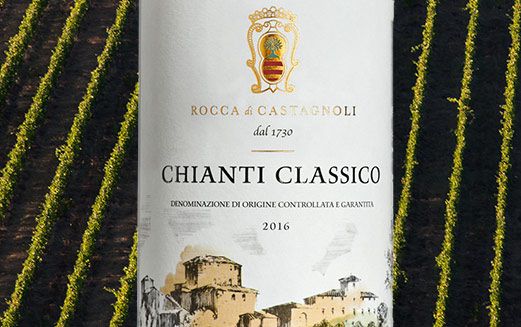
D.O.C.G.
If today the Chianti DOCG production area includes six provinces of Tuscany, the original nucleus on which the great production of quality Chianti wines is based is represented by a limited number of municipalities: Greve in Chianti, Castellina in Chianti, Radda in Chianti, Gaiole in Chianti and partially the municipalities of San Casciano Val di Pesa and Tavarnelle. The Chianti Classico DOCG denomination refers to this production area.
The legend of the Black Rooster
The black rooster has always been the emblem and trademark of Chianti Classico black rooster, a symbol that makes the bottles highly recognizable everywhere.
The origins of this brand date back to the Middle Ages, when the famous black rooster was the symbol of the Chianti Military League. The territory of Chianti, on the border between the Republics of Florence and Siena, has always been disputed between the two cities, to the point that according to legend it was decided to resolve the dispute and assign the borders once and for all in a rather unique way. .
At the crowing of the rooster, a knight would leave Florence and one from Siena and the border between the two republics would be established at the point where they would meet. The Florentines would then have adopted a witty stratagem that would have allowed their knight to leave before the Sienese one: the rooster had been kept in the dark and without food for a few days, so at the moment of acquiring freedom he would have sang immediately, even if not yet dawn had come. The Sienese one, on the other hand, as is natural, would have sung at the first light of the day, starting the knight with a considerable delay on the Florentine.
This is the reason why the borders of Chianti would have come almost entirely under the control of the Republic of Florence.
Disciplinary Chianti Classico DOCG
In the Regulations of the Chianti Classico D.O.C.G. as for almost all the main denominations of Tuscan reds, Sangiovese dominates, which in Tuscany finds its highest expressions in both Chianti DOCG and Brunello di Montalcino DOCG, in Nobile di Montepulciano DOCG and in many other Tuscan denominations.
The grape variety, which must be present for at least 80% in the blend, is characterized by a rather light ruby color, the nose is dominated by the typical hint of violet and in the mouth it is austere and decisive.
Numerous other complementary red grape varieties allowed for the Tuscany Region are also allowed in the Chianti Classico DCG denomination, even if in most cases the blends are made either with other native vines such as Colorino, Canaiolo, or with international vines such as Merlot and Cabernet sauvignon.
Unlike the Chianti DOCG Disciplinary, the Chianti Classico DOCG one does not provide for the possibility of adding white grape varieties.
The denomination includes three types of Chianti Classico DOCG:
Chianti Classico DOCG (minimum 11 months of aging)
Chianti Classico Riserva DOCG (minimum 24 months of aging, at least 3 in the bottle)
Chianti Classico Gran Selezione DOCG (minimum 30 months of aging)
Pairings Chianti Classico DOCG
As with the Chianti DOCG, traditional Tuscan cuisine offers many dishes that can be successfully combined with Chianti Classico. For vintage wines you can make a good combination with traditional soups, white meats and grilled meats. With the Riserva you can go further, towards prolonged cooking such as stews, braised meats, roasts, game and aged cheeses. With the Gran Selezione, which is usually made with the best grapes and which ages for a long time, it is advisable to combine foods that are equally intense in terms of flavor. Therefore, the same indications apply here for the Riserva, but the longer and more elaborate ones such as stews, braised meats, stewed game are preferred to quick cooking.
Characteristics of Chianti Classico in detail










